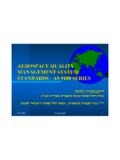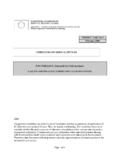Transcription of Interpreting Pre-Consumer Recycled Content …
1 Interpreting Pre-Consumer Recycled Content ClaimsPhilosophy and Guidance on Environmental Claims for Pre-Consumer Recycled MaterialsInterpreting Pre-Consumer Recycled Content Claimspage 2 PURPOSE AND INTRODUCTION 3 EMBRACING THE INDUSTRIAL ECOLOGY PHILOSOPHY 4 DEFINITIONS OF KEY Recycled Content TERMS. 5 BY-PRODUCT (CO-PRODUCT) 5 POST- consumer MATERIAL 5 Pre-Consumer (POST-INDUSTRIAL) MATERIAL 5 MANUFACTURING PROCESS 5 UNIT PROCESS 5 RECOVERED (RECLAIMED) MATERIAL 5 Recycled Content 5 Recycled MATERIAL 5 WASTE 5 WASTE STREAM 5 VIEW ON REWORK, REGRIND AND SCRAP 5 REGRIND 6 REWORK 6 SCRAP 6 GUIDING PRINCIPLES FOR VALIDATING Pre-Consumer Recycled Content CLAIMS 7 REFERENCES 8 APPENDIX: EXAMPLES OF Pre-Consumer Recycled Content 9 PLASTICS 9 MINERALS, CONCRETE AND ASPHALT 9 METALS 10 ASSEMBLED PRODUCTS 10 CHEMICALS, PAINTS AND GLASS 11 Table of ContentsInterpreting Pre-Consumer Recycled Content Claimspage 3 Purpose and Introduction There is a great deal of debate within the environmental and manufacturing communities about which materials can be claimed as Pre-Consumer Recycled UL EnvironmentSM encourages an end to this debate.
2 Manufacturers, retailers and ultimately consumers stand to benefit from clarifying the kinds of materials and processes that contribute to how much Content within any given product can legitimately be considered Pre-Consumer Recycled . UL Environment has developed this document to provide clarity on Interpreting existing guidelines to validate claims of Pre-Consumer Recycled Content and to serve as a reference for manufacturers. It is our position that it is time to move beyond defining the terms and to focusing on the vision and goals that drive us to consider Recycled Content in products a valuable primary motivation behind most recycling programs is to keep material from becoming waste, and subsequently entering landfills or being incinerated. Manufacturers that are doing just this should be encouraged to market their products as Pre-Consumer Recycled Content .
3 When Interpreting the definition for Pre-Consumer Recycled Content , UL Environment is guided by a holistic philosophy of industrial ecology which seeks to encourage the minimization of all waste. This view moves past the debate about definitions toward creating a more sustainable purpose of this document is to share an industrial ecology-focused position on Interpreting Pre-Consumer Recycled Content claims. Moving forward, UL Environment will use this ideology when making decisions on Recycled Content claims. This document will provide clarity about how UL Environment interprets those guidelines and will be available for the broader environmental and manufacturing communities to use as distinguish between accurate and inaccurate claims of recycling during the manufacturing process, UL Environment follows, and will continue to follow, guidance provided by the Federal Trade Commission (FTC) Green Guides (16 CFR Part 260), European Union regulations, and the ISO 14021:2001 definitions when Interpreting Environmental Claims Validations (ECVs) for Recycled Content .
4 When evaluating a product to a standard, UL Environment uses the definitions and guidance provided in the sustainable product consensus standards first, and refers to this document when further clarification is needed. Additional future standards developed by UL Environment or other standard development organizations should contain more industry-specific clarification for assessing Recycled Content . Interpreting Pre-Consumer Recycled Content Claimspage 4 Embracing the Industrial Ecology Philosophy UL Environment encourages a holistic approach to sustainability when Interpreting Pre-Consumer Recycled Content claims. Industrial ecology, a framework to examine sustainability in industrial systems, embodies the viewpoint that a manufacturing system should be a closed-loop system in which waste from one process is the raw material for another.
5 The goal of industrial ecology is to reuse waste materials, resulting in zero waste going to landfills or being this goal in mind, the recycling process takes discarded materials from end users and reuses them to create new products. Therefore, Pre-Consumer recycling is any movement of material from a finished or partially finished product backwards into the production chain. When a material destined for landfill is instead used as a raw material in a new product, this new product has Recycled Content . It should be clear that in order for a product to have Recycled Content , the Recycled material has to appear in the final product. This nuance may seem trivial, but materials such as solvents can be Recycled within a process but not appear in the final product. It is considered good manufacturing practice to reuse solvents to minimize waste and increase process efficiency, but Recycled Content claims will be made only if a process material appears in the final key issue is the distinction between waste and a by-product.
6 Although the difference may be subtle, it is important to understand the difference and be able to determine if a material is waste or a by-product. The industrial ecology philosophy does not consider a by-product of a manufacturing process to be waste. Therefore, by definition, a by-product cannot be included as Pre-Consumer Recycled Content . According to the European Commission, a material should be considered waste if a use cannot be identified for the material, it does not meet technical specifications, and/or there is no market for the material. In addition, the European Court of Justice may consider a material waste if a manufacturer seeks to minimize the amount of material produced. The European Parliament and the Council of the European Union Directive 2006/12/EC Annex I also lists a number of waste categories, which are followed by European manufacturers and are helpful when classifying waste materials.
7 UL Environment considers this guidance in distinguishing whether a product is waste or a by-product as well as the definitions in this industrial ecology philosophy leads to a rather generous definition of recycling. Some may say the definition is too generous and will discourage the environmentally responsible behavior of waste minimization. UL Environment seeks to incentivize recycling by encouraging recycling and reuse of all waste materials, even if it s a good manufacturing practice versus a new idea for material reuse. Manufacturers do have a financial incentive to avoid creating waste but companies that reuse waste materials in their finished products should be able to take credit for their Pre-Consumer recycling is any movement of material from a finished or partially finished product backwards into the production chain.
8 When a material destined for landfill is instead used as a raw material in a new product, this new product has Recycled Environment seeks to incentivize recycling by encouraging recycling and reuse of all waste materials, even if it s a good manufacturing practice versus a new idea for material Pre-Consumer Recycled Content Claimspage 5efforts. If there is no publicly available standard Recycled Content percentage for a product or material, it is not fair to exclude certain practices because they are considered common. However, the manufacturer must always be honest and make sure their claims are not deceptive to the user. Sustainability and the promise of industrial ecology are well served when materials, for whatever reason, are diverted from landfill or FTC Green Guides were developed for the purpose of claims verification to ensure consumers are not deceived.
9 By clearly stating the source of Recycled Content , compliance with the Green Guides can be satisfied. The definition from ISO 14021:2001 will also be met with specific clarification around the exclusions provided in that definition. UL Environment has chosen to provide more extensive, but complementary, definitions of Pre-Consumer of Key Recycled Content TermsWhile many of the sustainable product consensus standards base their Recycled Content definitions on ISO 14021:2001, each standard has its own unique variations on key terms. In some instances, broad interpretation of existing terms may exclude any waste from being called Recycled Content , or may result in inconsistent applications of the definitions that create a bias toward non-vertically integrated manufacturers. UL Environment has developed definitions for the most relevant terms associated with Pre-Consumer Recycled Content .
10 These key terms are based on publicly available definitions from various sources as well as UL Environment s experience and (Co-Product)A production material that is not waste and possesses characteristics that make it ready for further use in the marketplace without any further processingPost- consumer MaterialMaterial that has reached its intended end user which is no longer being used for its intended (Post-Industrial) MaterialMaterial diverted from the waste stream during a manufacturing process that has never reached the end user. Excluded is the reutilization of materials generated in a process and capable of being reused as a substitute for a raw material without being modified in any ProcessSequence of interdependent and linked procedures or actions designed to convert inputs (material, parts, etc.) into outputs (waste, by-product, etc.)



